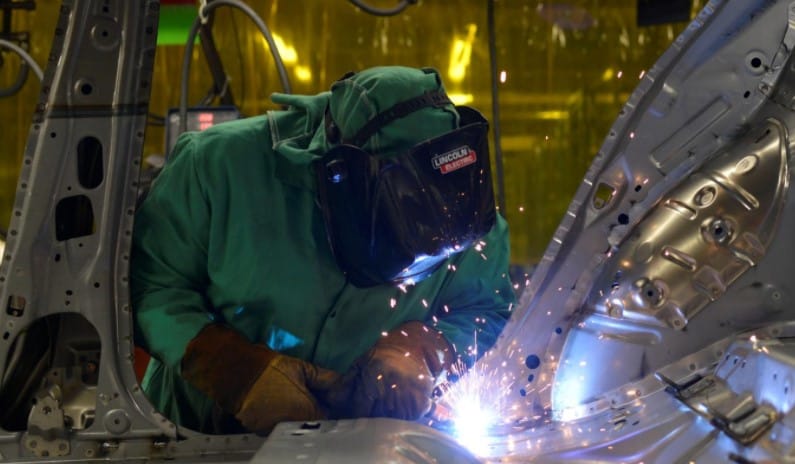U.S. manufacturing activity increased more than expected in August as new orders surged to their highest level in over 16-1/2 years, but employment at factories continued to lag amid safety restrictions intended to slow the spread of COVID-19.
The upbeat report from the Institute for Supply Management (ISM) strengthened expectations for a sharp rebound in economic activity this quarter, though the outlook is uncertain as money from the government dries up. Manufacturing is not out of the woods yet as the coronavirus crisis lingers.
Factory activity is being driven by demand for goods used at home like electronics while capital investment remains weak. The ISM said manufacturers described sentiment as “generally optimistic, though to a lesser degree compared to July.” The economy, which slipped into recession in February, suffered its deepest contraction in at least 73 years in the second quarter.
“The economy isn’t back to normal regardless of what these upbeat surveys of purchasing manager executives are telling us,” said Chris Rupkey, chief economist at MUFG in New York. “Time will tell if companies should be more vigilant about expansion plans. Government pandemic stimulus programs are starting to sputter, and attempts to limit bankruptcies and foreclosures, and those paycheck protection schemes, are all set to fade.”
The ISM said its index of national factory activity increased to a reading of 56.0 last month from 54.2 in July. That was the highest level since November 2018 and marked three straight months of growth.
A reading above 50 indicates expansion in manufacturing, which accounts for 11% of the U.S. economy. Economists polled by Reuters had forecast the index rising to 54.5 in August.
Underscoring the uneven landscape, manufacturers of transportation equipment said “airline industry continues to be under great pressure.” Makers of machinery said “capital equipment new orders have slowed again.”
In contrast, manufacturers of electrical equipment, appliances and components reported “strong demand from existing and new customers.” Similar sentiments were echoed by makers of chemical, wood and fabricated metal products.
Fifteen industries including wood, primary metals and computer and electronic products reported growth in August. Printing and related support activities, petroleum and coal, and furniture and related products contracted.
“Manufacturers tied to services hit hard by the pandemic continue to struggle,” said Sarah House, a senior economist at Wells Fargo Securities in Charlotte North Carolina. “As the pandemic drags on… manufacturers, even those tied most tightly to goods spending, are hardly in the clear.”
For now manufacturing is chugging along, and also picked up across the world in August. Factory activity in China expanded at the fastest clip in nearly a decade last month, while manufacturing remained on a recovery path in the euro zone.
Stocks on Wall Street were trading higher. The dollar dipped against a basket of currencies. U.S. Treasury prices rose.
EMPLOYMENT TRAILING
The ISM’s forward-looking new orders sub-index increased to a reading of 67.6 in August, the strongest since January 2004, from 61.5 in July. Fifteen industries reported an increase in demand. Only one industry said orders declined. A measure of customers’ inventories dropped to its lowest level since June 2010, an indication that orders could rise further.
The survey’s measure of order backlogs at factories increased as did orders for exports.
Though factory employment continued to improve last month, it remained in contraction territory. The ISM’s manufacturing employment measure rose to a reading of 46.4 from 44.3 in July. This measure has now contracted for 13 straight months.
According to the ISM “companies and suppliers operated in reconfigured factories, with limited labor application due to safety restrictions.” It said “long-term labor market growth remains uncertain.”
Factory employment was already in decline before the coronavirus crisis because of the Trump administration’s trade war with China. Its struggle to rebound even as orders received by factories are rising fits in with economists’ views that the labor market is losing steam after being boosted by the reopening of businesses in May.
The government’s closely followed employment report to be released on Friday is expected to show 1.4 million jobs created in August after 1.763 million were added in July, according to a Reuters survey of economists. That would leave nonfarm payrolls about 11.5 million below their pre-pandemic level.
Even with manufacturing now in what some economists say is a V-shaped recovery, business investment remains lackluster.
A separate report from the Commerce Department on Tuesday showed construction spending edged up 0.1% in July after falling 0.5% in June, confounding economists’ expectations for a 1.0% rebound. While low mortgage rates boosted investment in homebuilding, outlays on nonresidential construction projects such as office infrastructure and power fell, potential headwinds to manufacturing.
Spending on public construction projects tumbled 1.3%, with big declines in education, highways and streets.
“Public construction will continue to be held down as state and local budgets are squeezed by the pandemic,” said Nancy Vanden Houten, lead U.S. economist at Oxford Economics in New York.

